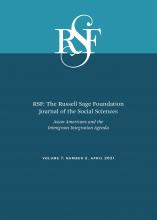Research Article
Open Access
Fault Lines Among Asian Americans: Convergence and Divergence in Policy Opinion
Sunmin Kim
RSF: The Russell Sage Foundation Journal of the Social Sciences April 2021, 7 (2) 46-67; DOI: https://doi.org/10.7758/RSF.2021.7.2.03
Sunmin Kim
aAssistant professor of sociology at Dartmouth College, United States

REFERENCES
- ↵
- Alba, Richard, and
- Victor Nee
- ↵
- Anderson, Benedict
- ↵
- Azuma, Eiichiro
- ↵
- Bloom, Joshua, and
- Waldo Martin
- ↵
- ↵
- Bourdieu, Pierre
- ↵
- Brubaker, Rogers,
- Mara Loveman, and
- Peter Stamatov
- ↵
- Bruckmayr, Philipp
- ↵
- Chin, Margaret
- ↵
- ↵
- Espiritu, Yen Le
- ↵
- ↵
- Gossett, Thomas
- ↵
- Hacking, Ian
- ↵
- Hagenaars, Jacques, and
- Loek Halman
- ↵
- Haney-Lopéz, Ian
- ↵
- Hoang, Kimberly
- ↵
- Hollinger, David
- ↵
- Ishizuka, Karen
- ↵
- Jacobson, Matthew
- ↵
- Jiménez, Tomás
- ↵
- Jones, Donna
- ↵
- Jung, Moon-ho
- ↵
- Keevak, Michael
- ↵
- Kim, Claire Jean
- ↵
- Kim, Sunmin
- Knight, Carly, and
- Mary Brinton
- ↵
- Lee, Erika
- ↵
- Lee, Erika, and
- Judy Yung
- ↵
- Lee, Jennifer, and
- Monika Yadav
- ↵
- Lee, Taeku
- ↵
- ↵
- Mora, G. Cristina
- ↵
- Nagel, Joane
- ↵
- ↵
- Pew Forum on Religion and Public Life
- ↵
- Ramakrishnan, Karthick,
- Jennifer Lee,
- Taeku Lee, and
- Janelle Wong
- ↵
- Ramakrishnan, Karthick,
- Janelle Wong,
- Taeku Lee, and
- Jennifer Lee
- ↵
- Roediger, David
- ↵
- Scupin, Raymond
- ↵
- ↵
- Trankell, Ing-Brit, and
- Jan Ovesen
- ↵
- ↵
- Vermunt, Jeroen, and
- Jay Magidson
- ↵
- Wei, William
- ↵
- Wimmer, Andreas
- ↵
- Wong, Janelle,
- Karthick Ramakrishnan,
- Taeku Lee, and
- Jane Junn
- ↵
- ↵
In this issue
Fault Lines Among Asian Americans: Convergence and Divergence in Policy Opinion
Sunmin Kim
RSF: The Russell Sage Foundation Journal of the Social Sciences Apr 2021, 7 (2) 46-67; DOI: 10.7758/RSF.2021.7.2.03
Jump to section
Related Articles
- No related articles found.
Cited By...
- No citing articles found.





